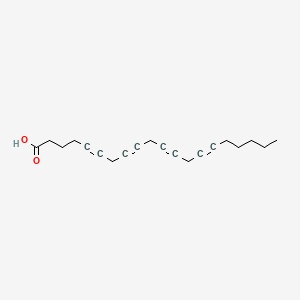| Harper MJ et al. |
Role of prostaglandins in contractile activity of the ampulla of the rabbit oviduct. |
1980 |
Am. J. Physiol. |
pmid:7361890
|
| Coupar IM |
Prostaglandin action, release and inactivation by rat isolated perfused mesenteric blood vessels. |
1980 |
Br. J. Pharmacol. |
pmid:7378646
|
| Wilson GB et al. |
Effects of dialyzable leukocyte extracts (DLE) with transfer factor activity on leukocyte migration in vitro. IV. Two distinct effects of DLE on leukocyte migration can be produced by prostaglandins. |
1980 |
Clin. Immunol. Immunopathol. |
pmid:7379353
|
| Lerner U |
Indomethacin inhibits bone resorption and lysosomal enzyme release from bone in organ culture. |
1980 |
Scand. J. Rheumatol. |
pmid:7455622
|
| Falkenhein SF et al. |
Effect of the 5-hydroperoxide of eicosatetraenoic acid and inhibitors of the lipoxygenase pathway on the formation of slow reacting substance by rat basophilic leukemia cells; direct evidence that slow reacting substance is a product of the lipoxygenase pathway. |
1980 |
J. Immunol. |
pmid:6103910
|
| Watanabe-Kohno S and Parker CW |
Role of arachidonic acid in the biosynthesis of slow reacting substance of anaphylaxis (SRS-A) from sensitized guinea pig lung fragments: evidence that SRS-A is very similar or identical structurally to nonimmunologically induced forms of SRS. |
1980 |
J. Immunol. |
pmid:6104681
|
| Spies C et al. |
Inhibitory effects of mepacrine and eicosatetraynoic acid on cyclic GMP elevations caused by calcium and hormonal factors in rat ductus deferens. |
1980 |
Naunyn Schmiedebergs Arch. Pharmacol. |
pmid:6245377
|
| Smolen JE and Weissmann G |
Effects of indomethacin, 5,8,11,14-eicosatetraynoic acid, and p-bromophenacyl bromide on lysosomal enzyme release and superoxide anion generation by human polymorphonuclear leukocytes. |
1980 |
Biochem. Pharmacol. |
pmid:6245654
|
| Smolen JE and Weissmann G |
Lysosomal enzyme release from human granulocytes is inhibited by indomethacin, ETYA, and BPB. |
1980 |
Adv Prostaglandin Thromboxane Res |
pmid:6246788
|
| Briggs RG and Derubertis FR |
Calcium-dependent modulation of guanosine 3',5'-monophosphate in renal cortex. Possible relationship to calcium-dependent release of fatty acid. |
1980 |
Biochem. Pharmacol. |
pmid:20227946
|
